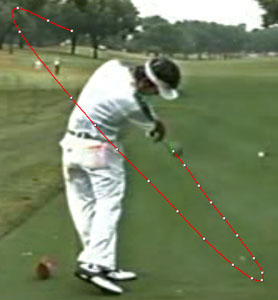
In Homer Kelley's 'The Golfing Machine', he discusses 'snares' which are flaws to the golf swing. Mr. Kelley discusses them in 3-F-7. Let's take a look:
3-F-7-0. MACHINE ADJUSTMENT CHECK LIST The Twenty-Four Stroke Components are those things the Machine should do. Then there are some indications and symptoms of maladjustment - things it should not do. (See 4-D and 6-D).Remember, Mr. Kelley looked at the swing as a 'machine' with 24 parts (aka components). So the components are things the golf swing *should* do and there are some maladjustments that golfers make that the swing should *not* do.
3-F-7-A. STEERING is the Number One malfunction -- The Bent Left Wrist and Clubhead Throwaway. Any or all of the following faults during Impact may need to be adjusted out --- holding:So somebody who 'steers' (like myself) does any or all of the following:
1. The Clubface square to the Target Line
2. The Clubhead on Target Line
3. The Clubhead on a level or upward path.
A very successful and anti-steering therapy is an exaggerated 'inside-out' Cut Shot, per 10-5-E. (Study 2-J-3, 2-N and 12-3-39.) You always Swing along the Plane Line but not always along the Flight Line. So learn to dismiss the Flight Line. Depend on Clubface alignment for direction control (2-J). In fact, learn to execute all Plane Line Variations (10-5) to remove all uncertainty from your Computer (14-0).
- Clubface square to the target line (instead of the clubface 'closing' naturally)
- Clubhead on the target line (instead of being arced inward)
- Clubhead on a level or upward path (instead of going 'down, out and forward).
Also note how Mr. Kelley stated that steering is the 'number one malfunction.' I'm not sure if he means it's the most common malfunction or the worst malfuction or both. I'll have to figure that out.
Take a look of this picture of Kevin Na's swing.

The red line shows the 'circular plane' that Kevin Na is swinging on. Na is on his 'circular plane' and the toe of the clubhead is pointing upward. A 'steerer' would either have the clubhead still on the target line and/or have the clubface pointing at the target right here.
Some people ask why it's important to have the club in these position similar to the way Na has it after impact when the ball is already gone. The reason being is that in order for the golfer to get in whatever position they are in right after impact, they must *prepare* for it *before* they hit the ball. So if you are a 'steerer', then you are essentially steering right before impact and that causes less than optimal golf shots.
Furthermore, steering usually results in a 'bent plane line', which I will describe later
3-F-7-B. QUITTING slows or stops the Hands during Release and is almost always a semi-conscious maneuver to change the Down-and-Out Clubhead Path (2-J-2) to an On-Line Path through Impact, on the mistaken assumption that this is the purpose of the 'Wrist Roll' (2-G) and/or 'Wrist Bend (6-D-3) and that such Clubhead control is, somehow, automatic Clubface control. That is a distorted interpretation of Sequenced Release (4-D). This results in:'Quitting' is when the hands slow down, often times due to the golfer 'stalling' their pivoting hips. Mr. Kelley also believed that this was a 'semi-conscious' move by the golfer due to misinterpreting the finish swivel.
1. a Bent Plane Line (Steering 4-D-0)
2. a shortening of the Swing Radius (loss of effective Mass); AND, depending on Impact Hand Locations results in either:
3. a 'Down Only' Clubhead Path (deep Divot or 'Fat' Hit 1-L-14);
4. an 'Up-and-In' Clubhead Path (Topped Shot 2-J-2)
Also study 2-C-3. The inherent power loss causes the player to swing even faster, aggravating the who situation. Rhythm (2-G) is the solution --- Quitting is actually impossible with proper and continuous Rhythm. So are many other faulty moves during the Stroke. During all Strokes --- INCLUDING, AND ESPECIALLY, WITH PUTTING.SUSTAIN THE LAG! That is, Hitting or Swinging, losing Lag Pressure not only produces Quitting but jeopardizes Rhythm and destroys the Basic Motion, and worst of all, dissipates the Line of Compression (2-0 and 6-C-2-o)
Mr. Kelley states that 'quitting' results in a 'bent plane line.'
A bent plane line happens when the a part of the clubshaft is not pointing at some part of the target line at some point in the swing. Bent plane lines can actually happen in the backswing or the downswing, but Mr. Kelley is talking about a bent plane line in the follow through for 'quitters.' Robert Allenby here has a 'straight plane line.'

A 'bent plane' would have the golf clubshaft much more vertical so the clubshaft is pointing more at his toes or extremely flat so it's pointing towards the caddy. That being said, usually a bent plane line in this position is very vertical.
Mr. Kelley also states that 'quitting' decreases the width of the golfer's swing (aka shortening the swing radius). And depending on where the hands are at impact that will result in either fat shots or topped shots because the golfer cannot move the clubhead in the proper 'down, out and forward' motion.
And because a golfer 'quits' it causes a loss of power and the golfer will then try to swing harder which only makes the situation worse. The solution according to Homer Kelley is proper rhythm and he states that with proper rhythm the golfer cannot quit. Here's Mr. Lynn Blake dropping knowledge on what rhythm really is.
Mr. Kelley concludes that rhythm is the key with ALL strokes, especially the putting stroke. Regardless if the golfer 'hits' or 'swings' the golf club, they need to create lag and then *sustain* the lag. Quitting causes the golfer to not sustain that lag and destroys all type of rhythm.
Part II coming up....
3JACK
No comments:
Post a Comment